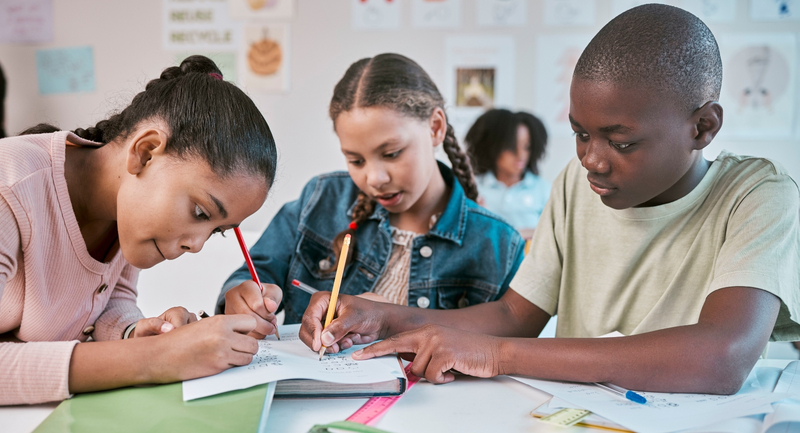It is a Sunday night after a school break. I stand at my bathroom sink, watching what is left of my nail polish wash away in a puddle of shimmer and acetone. Doing my nails is an act of self-care and, I realize, is deeply tied to my identity: It allows me to step outside of an oppressive binary gender role and express who I am on the inside. It is a visual reminder that I am living my truth. Yet, on a Sunday night, I watch that sparkle float down the drain. I have to get ready to go to work as a teacher and school leader the next day—and pretty nails are not part of the dress code.
As someone who can pass as a cisgender male, I rely on the safety and security of my outward identity to meet commonly accepted professional standards set by my job environment. In other words, I need to hide my true and full self to be accepted as a teacher and administrator.
Every room I walk into, every meeting or school event I attend, I need to read the room and decide how safe it is to be me. For example, simply being asked, "How was your weekend?" can lead to an uncomfortably stressful and unsafe situation. Do I share that my partner and I had a great adventure together? Or will that be seen as unprofessional, indoctrinating, or flouting my sexuality? It’s often safer for me to stay silent.
But educators cannot afford to be silent in the face of anti-queer discrimination. School leaders must take steps toward creating the conditions that allow LGBTQIA+ staff and students to speak their truth. While schools have a lot of work to do when it comes to diversity, inclusion, and belonging, there are actionable practices leaders can put in place to acknowledge existing inequities, advocate for systemic and structural change, and support queer students and staff as part of the school community.
Making Progress
It can feel challenging to advocate for change when my LGBTQIA+ colleagues across the nation are faced with the threat of being fired for being gay. I see news reports of hateful political campaigns to remove from schools the words that describe who I am. I watch as my LGBTQIA+ community endures hateful attacks through rhetoric resounding from the legislative floor as politicians try to outlaw our existence or propose bills to out students in the trans community, causing irreparable harm.
As political tensions intensify, leaders must consider how the perspectives and experiences of LGBTQIA+ staff, such as myself, are an inherent part of the school community. Creating a community of inclusion, belonging, and equity starts with recognizing how systemic inequities and microaggressions show up throughout the structure of the community itself, from policy and pedagogy to day-to-day practices like dress codes, gendered restrooms, and gendered sporting events.
LGBTQIA+ staff, students, and families are in a state of crisis that requires leaders not only create equity-seeking vision and mission statements but connect such statements to specific actions.
Examining the bureaucracy of schools can alert leaders to toxic power imbalances and institutionalized practices of exclusion. LGBTQIA+ staff, students, and families are in a state of crisis that requires leaders not only create equity-seeking vision and mission statements but connect such statements to specific actions. As a queer person, I feel most safe when I can trust someone with integrity, which means their words match their actions. I hold institutions and organizations to this standard of trust as well. As just one example, an easy but highly impactful practice for supporting LGBTQIA+ students, staff, caregivers, and community members is for leaders to add pronouns to their email signature. In taking a seemingly small step like this, leaders demonstrate alignment between the school’s mission statement and their own actions.
Navigating Stakeholders
In my district, our school community has been faced with cases of racism, anti-Semitism, sexism, and anti-queer discrimination. As a response, professional development days, curriculum programming, and school-community practices have all focused on supporting diversity, inclusion, and belonging. As a district, we have been working with the ADL (Anti-Defamation League), the Lappin Foundation (a nonprofit that operates programs for Jewish youth), and both national and regional advocacy groups and clinicians to provide training and consultations on curriculum material, pedagogy, and policy.
Some immediate changes to practice that we’ve made include implementing culturally responsive reading units for students and staff, providing curriculum resources that include LGBTQIA+ representation, supporting local events organized by our student-led GSA, flying the progress pride flag at all district buildings during Pride Month, and implementing social-emotional learning community blocks to foster relationships as a foundation for restorative action.
These community partnerships and trainings have been helpful in supporting teachers and staff. Professional development sessions build a collective staff knowledge base to increase understanding of LGBTQIA+ issues in education. PD sessions also give staff working knowledge to increase their comfort level addressing and intervening in school settings. Imagine it’s dismissal time and students are waiting for the bus in a crowded hallway. The teacher on duty overhears a student say the word “gay.” Previously, it would have been customary practice to say something to the student along the lines of “we don’t say that here.” This is a quick phrase to use when staff are uncomfortable or don’t know how to respond.
In reality, however, the teacher’s response is exclusionary of the LGBTQIA+ community, and it also does not help the student learn how to use the word “gay” appropriately or support inclusive language building. After our PD workshops, I’ve witnessed this exact scenario play out, but instead, the teacher engaged the student and asked, “What do you mean?” The student shared how they were talking with their friends about an NFL player who had come out as gay. The teacher commented that she was glad to hear them talking about current events. Asking a student for clarification opens the opportunity for educational dialogue around inclusive language—and it allows a teacher to intervene if language is causing harm. Instead of shutting the conversation down, the teacher was more comfortable intervening due to our recent PD.
Moments like this are important wins, but there have also been setbacks in our district: Parents and families in our community have put recent changes in practice under scrutiny. For example, each month our SEL block at the elementary level utilizes a culturally responsive read aloud that focuses on a different component of identity. For the focus of gender identity, gender expression, and gender stereotypes, recent texts we've used include, What Riley Wore by Elana K. Arnold, Teddy's Favorite Toy by Christian Trimmer, Julian Is a Mermaid by Jessica Love, and Calvin by JR and Vanessa Ford. There was significant pushback from staff and parents/families when the district first planned to implement this unit, and some staff refused to teach the material.
The leadership team, at first, were worried about the public relations and legal implications that such pushback could have in the societal context of growing anti-LGBTQIA+ legislation. However, they leaned into their resolve to introduce this unit: Building principals would meet with families that were concerned about the read alouds. When the principals explained that these readings aren’t about indoctrination and instead were about making sure all students feel safe and welcome, most parents and families understood.
By talking with concerned stakeholders while still implementing the curriculum programming, leaders showed their commitment to building equitable and inclusive experiences for LGBTQIA+ staff.
If the issues were continuing to escalate, our curriculum director, central office administrative team and even our superintendent would meet with parents. By talking with concerned stakeholders while still implementing the curriculum programming, leaders showed their commitment to building equitable and inclusive experiences for LGBTQIA+ staff.
Some staff have also pushed back against these units, so our curriculum leadership put together several workshops based on their feedback and concerns that addressed common misconceptions. While I was able to support our district and building leadership, it was refreshing as a queer staff member to know that our leaders were using their platforms and positions to support LGBTQIA+ persons in the school community. I was able to advise and help our leaders and colleagues with talking points, clarification of terms, and build their LGBTQIA+ knowledge base so they could go into these meetings with clarity and knowledge.
Meeting with stakeholders is a starting point. I would like to see more done in practice. For example, I have a guitar in my classroom (I’m a music teacher, too!), and the guitar’s name is Bee. Students will ask if Bee is a boy or a girl. My response is Bee is Bee. While I do not have a name tag on my guitar with pronouns, it helps students conceptualize non-binary identities. I hope to see more of these types of practices at our school, like ensuring inclusive language is represented in curricular resources across subject areas or creating a gay-straight alliance (GSA) student group at the elementary level, as this can really strengthen the sense of belonging among LGBTQIA+ students.
Being a Leader, Not a Bystander
As a queer educator and leader, I rely on a guiding principle: I believe that education is the antidote to bigotry. By speaking truth to both my identity as a queer person and my role as a teacher and education leader, I can educate as a form of advocacy. It is important to note that feeling safe is a privilege, one that I acknowledge and do not take for granted. Not every LGBTQIA+ person has such a luxury. So, I believe that with this privilege comes a duty: A duty to educate as part of how I advocate.
As a queer educator and leader, I rely on a guiding principle: I believe that education is the antidote to bigotry.
Since I’ve taken on a leadership role, I’ve realized the power I hold and the duty I have to advocate for my fellow LGBTQIA+ community. Sometimes, traumatic experiences from my past make silence feel like a safe spot. But then I see a colleague wearing a rainbow pin or a t-shirt that says “You Belong” in the colors of the progress pride flag, and I feel hope. Moments like these empower me to feel more comfortable with being my true self in my school setting. I also try to signal to students that I am a safe educator who is here to support them by decorating my classroom in rainbows and having a poster that says, “I want my LGBTQIA+ students to feel included, valued, safe, seen, heard, respected.” These are ways that I can maintain my visibility as a queer educator and leader.
I have resource texts for staff on my teacher bookshelf behind my desk. These texts include Beyond the Gender Binary by Alok Vaid-Menon, A Quick & Easy Guide to They/Them Pronouns by Archie Bongiovanni and Tristan Jimerson, The Stonewall Reader edited by The New York Public Library, Queer, a Graphic History and Gender, a Graphic Guide both by Meg-John Barker and Jules Scheele. I firmly believe the antidote to bigotry is education. These texts, along with open dialogue, form the basis of building knowledge around LGBTQIA+ issues, identities, and in turn, our humanity.
Aiming for Actionable Practices
To support queer students and educators, all leaders need to strive toward inclusion, belonging, and equity through actionable practices. Such practices include:
- Partnering with community resources and organizations to educate staff, students, and caregivers on LGBTQIA+ issues, knowledge, language, inclusive practices, and resources.
- Planning for pushback by having a clear action plan and strong policy rooted in local, state, and federal education law, while being resolutely committed to the work of being an advocate and ally—this means continuing to have habits of practice that put equity mission and vision statements into action.
- Partnering with parents, guardians, families, and caregivers with honesty and transparency as a means of building trust with through integrity. When clear words match clear actions, integrity and trust can grow.
- Examining organizational practices, systems, and structures and taking actions to reduce and eliminate harm.
- Affirming, protecting, and advocating for LGBTQIA+ students, staff, and school community members.
What these practices have in common is that they seek to uphold the humanity of all school community members. Leaders can honor the humanity of school communities by practicing inclusive language, honoring pronouns, and holding space for LGBTQIA+ staff, students, and families. These habits of practice could mean including pronouns in email signatures, wearing a pronoun pin, using gender neutral language both verbally and in written school policy documents or handbooks, or having a gender neutral dress code. These examples are relatively accessible practices schools can adopt that have a positive impact on LGBTQIA+ persons.
Leading a school community toward inclusion, belonging, and equity is an ongoing journey. While I have certainly seen progress, much work remains. If all leaders were courageous and equity-focused, educators wouldn’t have to hide or wash off that nail polish on Sunday nights. It may be a daunting journey for leaders, especially those brave ones advocating from within minoritized communities, but our world has shown that we can no longer be bystanders in education. Our school communities need and deserve better. So, perhaps one day, a sparkly manicure on my hands will bring a smile instead of a slur and make one queer educator shine bright for the next generation of queer school community members.








